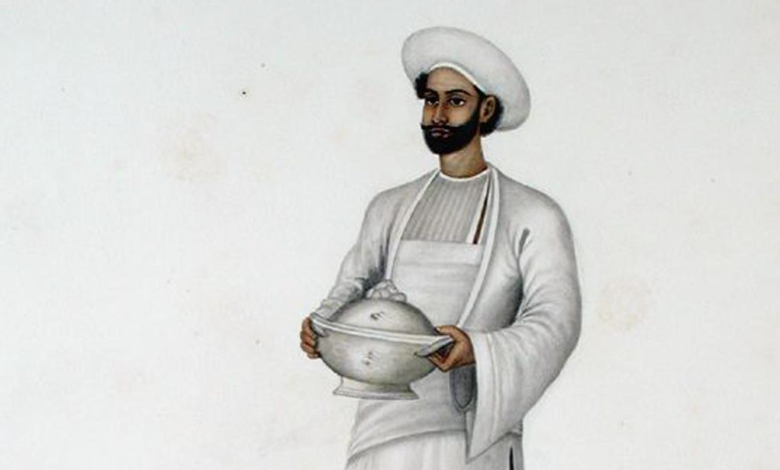The Myth Of The Indian Khansama Has Been Mixed With Fiction And Actuality

We are led to believe that the khansama was simply a skilled cook by popular culture. In actuality, he was much more. Journalist Joachim Hayward Stocqueler recounts the special role of the khansama in a typical Anglo-Indian home in The Handbook of British India (1854).
According to Stocqueler, the khansama was always a Mussulman or Parsee, and was required to be educated, respectful, and well-mannered. In the essay Men-Servants in India, civil servant CT Buckland states that the man would be dressed in white linen and have a dignified demeanor.
The liveried khansama existed long before the British took over the country, despite the fact that in post-colonial imagination it came to represent the grandeur of the Raj era. The Persian roots of the word “khansama” are kan, which means “master,” and saman, which means “domestic goods/materials.” One of the most significant officials in the Mughal court was the Khan Saman or Mir Saman, who oversaw the imperial household’s goods. He is referred to as the Grand Chamberlain of the royal household by François Bernier, a traveler who visited Mughal India in the 17th century. It was his responsibility to inspect the order in the palace, imperial establishments, and factories, similar to the position of the mayor of the palace in medieval Europe.
Feudal architecture
The khansamas were important figures in the nawab’s court as well, and some of them were elevated to greater political positions. For instance, when Ghazi-ud-Din Haidar Shah became the ruler of Awadh in 1814, he named Agha Mir, a khansama of his father Nawab Saadat Ali Khan, as prime minister.
Some academics believe that this usurpation has an evil purpose. For instance, Akbar S. Ahmed and Joseph L. Soeters think that the British utilized Islamic names to refer to lower positions in order to degrade Muslims.
The khansama was not a solely culinary term, even among colonial domestic institutions. The khansama and the bawarchi are distinguished in 19th-century colonial texts. The khansama served as the liaison between the memsahib and the kitchen crew, which included the bawarchi, despite the fact that the bawarchi toiled away in the kitchen cooking the food. In this way, according to Kabir, the khansama was a significant cultural mediator and creolizing agent: he mediated significant discussions between the cultural norms of his employer and that of his own country, and new culinary and domestic traditions sprang from these exchanges.
These exchanges led to the creation of a variety of hybrid foods, including roasts and steaks spiced with local spices, perfectly shaped minced cutlets flavored with a tinge of chilli, and caramel custard baked over charcoal. Country Captain, also known as County Koptan, is a meal that epitomizes this style. The skippers of country ships, who are likely to have enjoyed it very much, gave the dish its name. It is a straightforward curry prepared with a few spices.
Dak bungalows
The interactions between the khansama and his employer could be tumultuous, cynical, or even hostile. For instance, Buckland claims that the typical Khansama takes advantage of his position by buying the cheapest materials and selling them for the highest price. Others claim that Khansamas conspired with milkmen to tamper with the milk. According to a peculiar tale recorded by historian William Francis Patrick Napier, one khansama drove his own tribesmen around. Warren Hasting’s khansama in this tale convinced the locals that the colonial administration would have a chubby youngster slaughtered for breakfast unless they offered him a bribe, earning him Rs 3,000 a month.
Whatever the truth of that story, it is certain that the closeness of the khansamas to their colonial overlords gave them a higher position, even celebrity. Several streets and alleyways in old Calcutta bore their names. Nemoo Khansama Lane, Chakku Khansama Lane, Karim Bux Khansama Lane, and Pachu Khansama Lane are a few of the names that still exist.
For many Khansamas, the voyage that started in colonial residences wandered into the network of rest houses known as dak bungalows, which were constructed by the British as part of the imperial postal service. Khansamas performed the dual duties of caretaker and chef in many dak bungalows.
The truth is that not all dak bungalow khansamas were skilled cooks. Poor descriptions of the tasteless meals served at dak bungalows are common in historical sources. Most frequently, the khansamas would sloppily mix up a curry using readily available, recently butchered chicken and a few basic spices.
However, the dish could be exquisite in the hands of a skilled khansama. The khansama would prepare delicious dishes and multi-course feasts using his knowledge of European cuisine and the little ingredients at his disposal. One such magician was Peter, the khansama of the Krishaghur Dak Bungalow, who was dubbed the lone surviving celebrity of our time by civil servant William Tayler.
The khansama’s power continued after the British left. In her book Raj on the Move, Rajika Bhandari describes an incident involving Bernard, the khansama of the Bilaspur Circuit House, who was renowned for both his culinary prowess and his bad disposition. Prime Minister Jawaharlal Nehru was entrusted with Raja Saheb of Sarangarh’s care during his stay at the Circuit House when he was slated to visit Bilaspur in the early 1950s.
News Mania Desk






